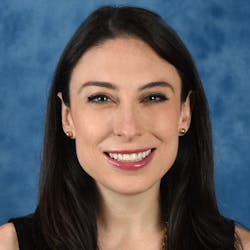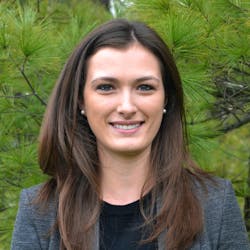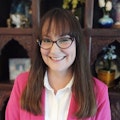A Look at the Current Pediatric Workforce
As hospitals continue to feel pressure from staffing shortages and tight budgets, one must not forget that the pediatric workforce is facing similar challenges, albeit with slight differences. Healthcare Purchasing News had the pleasure of speaking with Danielle A. Altares Sarik, PhD, APRN, CPNP-PC. Altares Sarik is a pediatric nurse scientist and director of Nursing Research and Evidence-Based Practice at Miami-based Nickalus Children’s Hospital. Altares Sarik has expertise in health services and outcomes research. She holds a PhD, MSN, and BSN from the University of Pennsylvania, and a BA from Cornell University. She is a Certified Pediatric Nurse Practitioner in Primary Care and has cared for patients in China, Botswana, and Nicaragua in addition to the U.S.
What does the pediatric workforce look like today?
As to the current status of the pediatric workforce Altares Sarik said, “In the pediatric world, generally, we have nurses that choose to go into pediatrics, and they tend to stay. We don't have a lot of nurses that bounce between pediatrics and adult care. It's kind of like a calling. But what we've seen recently is that we've had a lot of attrition from our pediatric nursing workforce. And actually, with the pandemic, what we saw was a lot of hospitals stopped allowing nurses to do their training rotations because of concerns with infection risk and COVID. And so, a lot of those nursing students who would normally be exposed to pediatrics during this their schooling didn't get those opportunities. So, what we are seeing as a consequence of that is we have less people choosing to opt into a career in pediatric nursing, because they've never had that exposure.”
She continued, “We're just seeing less nurses who are choosing as an initial career path to go into pediatrics. And then we're seeing huge amounts of nurses who are retiring, which is the same as the adult workforce, but because it's a smaller number of nurses who have chosen this career path. Also, we see a lot of our experienced nurses leave. Then what we see is challenges with training the nurses who do want to come in. We're also seeing less of our medicine colleagues choosing to go into these pediatric specialties.”
Altares Sarik stressed the training piece of the equation. She said, “For both medicine and nursing, we have training programs and academic programs, and across the board, I'll speak to nursing just because I know that world much better, but what we're seeing is we have faculty shortages. In the schools of nursing, it is we're seeing a lot of our older, more experienced faculty retire, and we actually don't have enough faculty to replace them. And what that means is not only are we seeing challenges with nurses after they graduate from school, opting to go into pediatric careers, what we're actually seeing is we're going to lose capacity to train nurses at the undergraduate level or the graduate level, because we just don't have enough faculty and staff in these academic settings. And so that's a really big challenge.”
Some of the reasons, according to Altares Sarik, for this are pay discrepancy, the faculty in schools of nursing tends to be very low and it is hard to therefore attract instructors. Then, the training process is very long. To get a PhD, which is needed to be faculty, one has to go through four or five years of a PhD program. Sometimes a postdoc is required, which is an additional one or two years.
Impact on the future
Altares Sarik painted a troubling picture of the future. When asked about the potential impacts, she said, “If you think about your nursing workforce or your pediatric medical workforce you need to be able to replace those people who are either retiring or leaving the profession at the same rate that so that we can reach that balance point. But if we're not able to recruit enough pediatric nurses in or we're not able to fill our medical specialties, what that means is for future care, we may be in a situation where we don't have an adequate workforce to provide the care needed to pediatric patients. What that can look like is, if you're looking for a specialist, increased wait times, maybe longer distances that families and patients have to travel to be able to find specialists.”
She continued, “And then if you need to be hospitalized and you're looking for that kind of unique pediatric care if we don't have enough pediatric nurses to provide that care, that can look like shortages, where you have really high staffing, you know, really high ratios of patients to nurses where we like to keep those ratios low so that we can have really great hands-on care. And that can provide a lot, or that can lead to a lot, of challenges with just actually being able to provide the care in hospital. Additionally, when you think about community care and primary care what that can look like is longer wait times to get in to see a provider. It can look like maybe not having pediatric providers in some areas or rural areas or underserved areas. And that can be really challenging, especially if you're not located in a city. That can be a huge barrier to receiving the needed care.”
The role of a pediatric nurse scientist
Perhaps an overlooked career path is the pediatric nurse scientist. Altares Sarik said, “Basically a nurse scientist is a nurse with advanced training and advanced education, usually a PhD, but sometimes they could also be a DNP, which is a Doctorate of Nursing Practice degree. The nurse scientist has a clinical background, they've been trained clinically as a nurse, they've likely practiced in the hospital setting or like myself, I was in the pediatric outpatient setting, and then they have the additional training and education that allows them to have a research kind of background and be able to address issues from that research perspective.”
She added, “So, what makes that really unique is for a clinical pediatric nurse scientists like myself, I have the training that I could be a faculty in a school of nursing, but instead I'm embedded in the clinical setting. And so I get to teach the nurses I get to provide support for scholarship in the academic or in the clinical setting so that things like doing evidence-based practice work, quality improvement, work, research, and then I help to provide at the system level support, like infrastructure, to be able to address some of the problems we see on a day-to-day basis. We know that nurses are the ones at the bedside, they spend the majority of time with patients and families. So, they often see where we have gaps in care, or they see where we have opportunities to improve our care. The role of a clinical pediatric nurse scientist is often to partner with them to help them take those issues that they're seeing or those challenges that they're seeing and help them to address it from kind of a scientific or an academic perspective. And so, what that means is that instead of having to wait until maybe research is done in the academic setting, where it could take many years for a researcher to get some data and be able to analyze it and write it up and make changes, we can make changes in real time.”
Easing the burdens
Sarik commented, “If I have a nurse that comes to me and tells me we've noticed that we are having a really high incidence of, say, pressure, injuries in this unit and we're thinking it's because of X,Y, or Z issue, I can then partner with them to put together a protocol so we can study it and we can then quickly implement a change in practice. Then, we can evaluate the outcomes of that change in practice. And so, in a very short period of time, we can improve the care we're providing to patients and improve the outcomes that we're seeing. It's an area where you can kind of take that unique training and those unique skill sets of a nurse, partnered with research training so we can really address issues in a very, very efficient way that otherwise we wouldn't be able to.”
Altares Sarik noted some projects that she’s been involved in recently that are helping nurses with an ever-increasing workload. She said, “One is looking at using virtual reality (VR) for needle procedures in the EEG. Sometimes the collaboration that happens between the nurse scientist and the nurses, or the team, leads to bringing in new devices or new products, or trialing new products. If they are thinking about a new device, like a new mesh we started using—a new protective barrier for nasal cannulas to help with decreasing pressure injuries—a nurse scientist is partnering with those teams to help bring in those potential innovations and help support them, implementing the use of them and then evaluating whether or not they're a good solution for the unit at the hospital.”
Sidebar:
One CEO shares her perspectives on female physician needs
Julia Jacobson, CEO of BLOXR Solutions, recently spoke with Healthcare Purchasing News about her company and the unique needs of female physicians.
By Janette Wider
Can you give us some background on your company?
What trends have you seen regarding female physicians in the workforce?
From attending the same industry tradeshows and conferences for 10 years, we can see there are more and more women becoming surgeons. We hope their needs are taken more seriously as they are no longer the minority in each field and are moving into positions of leadership (the decision makers). Unfortunately, we are continually told that female employees are not provided with adequate radiation protection. Many choose to buy radiation protection gear on their own if the hospital does not provide them with gear that fits.
Can you give us some insight as to why female physicians may need different products than male physicians?
In the world of radiation protection, female clinicians need different products for several reasons. Many female clinicians are given aprons that do not fit or are sized up to fit multiple people (they share gear), leaving sensitive areas exposed. This is especially common for breast tissue if the apron has a gaping armhole because it is too large. In December 2023, an article from the British Medical Journal states, “They point to observational evidence suggesting an increase in breast cancer risk among female U.S. orthopaedic surgeons compared with an age matched female population.” And a small Finnish study, noted in a Safety + Health, shows breast cancer at 1.7 times the expected rate in radiologists, surgeons, and cardiologists compared with female physicians not working with radiation.
According to an article from Diagnostic and Interventional Cardiology, female physicians also may be pregnant while working in a job that exposes them to radiation. It is commonly known that “a developing child is particularly vulnerable to radiation’s dose-dependent effects, which can include death or congenital abnormalities that appear at birth or later in life.”
Why aren’t employers more aware of occupational risks?
I believe hospitals are aware of the risk of radiation exposure for their clinicians. Many cite budgetary restraints as the reason why they cannot buy their female clinicians radiation protection that fits and fully protects them. There is no way to conclusively prove that someone got cancer as a result of their radiation exposure on the job—no one knows how one’s cancer came to be present. Your thyroid is highly susceptible to radiation—I have met maybe a dozen people now (from industry events) who have had their thyroid removed due to cancer. All were physicians who were exposed to radiation as part of their job and most said they “know they got it from work.” How many people do you know who have had their thyroid removed due to cancer? It seems a little too common among clinicians who work with radiation to say there is no correlation.
Do you think that there will be more concern in 5-10 years?
There are frequently new articles pointing to higher rates of cancer amongst physicians exposed to radiation as part of their job, and especially for female physicians and breast cancer. I always contact the people in these articles to let them know about our bra inserts and products made for women. One time, my email bounced back, and I Googled the doctor to find out she had just died of breast cancer, just after her 33rd birthday. She attributed this to her radiation exposure on the job. The danger is very real, and awareness is key so female physicians can adequately protect themselves and start cancer screening early.
In an article featured in Mother Jones, Emily Zhao, M.D., commented, “No one had mentioned the increased risk of cancer with my profession … If I knew it was a risk, then I would have checked more and maybe caught it sooner.” I hope that these articles continue to be published so more doctors are aware of their risks.
What does the future look like for female physicians who may face occupational risk at their job?
Hopefully, female physicians become more aware of their occupational risks in a profession that exposes them to radiation. If they are knowledgeable of these risks, they can take steps to protect themselves (buy radiation protection that fits!) and also start early testing for cancer detection.
Any other thoughts regarding women’s health and technologies/innovations?
As more women enter the healthcare field, new technologies will target their needs. BLOXR does this with our pregnancy protection, bra insert protection, and custom fitting lead to confirm adequate protection from radiation. We hope it becomes a requirement that all hospitals provide their female clinicians with adequate protection so we can mitigate the risks of cancer.



